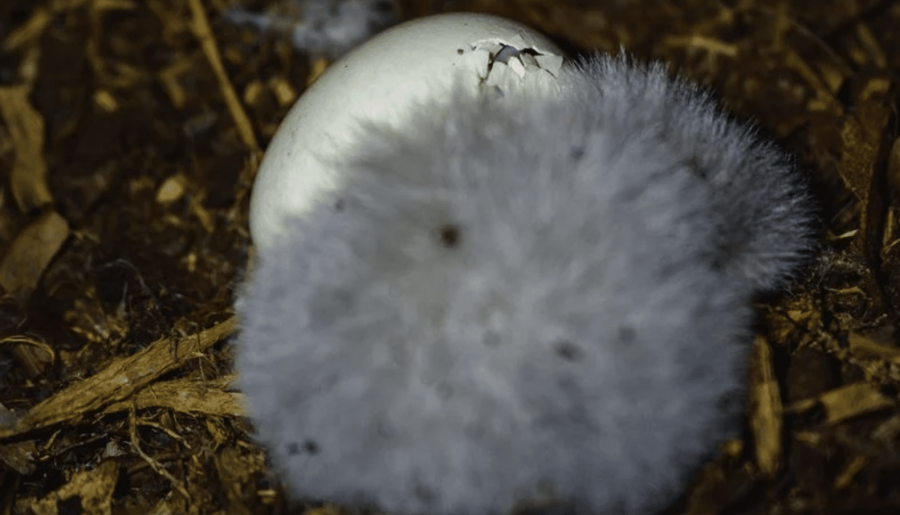The first kākāpō chick of the season has hatched on Whenua Hou, west of Rakiura/ Stewart Island, says the Department of Conservation.
Nineteen-year-old kākāpō Pearl has produced the first chick of the year – Pearl-A-1-2022. The chick was observed in the nest at 2am yesterday morning (1 February) looking fluffy enough for staff to conclude it was a January chick. The chick’s name comes from the naming convention for the species – mother’s name, egg number, and the year.
Although Pearl-A-1-2022 is the first of Pearl’s 2022 clutch, she also has two other eggs, due to hatch over the next few days. One is in her nest, while the other has been moved to an incubator on Anchor Island to give it the best chance of survival. It will be buddied up with a chick of a similar age and reared by a foster mum.
Baby Pearl-A-1-2022 received a health check at 5am this morning (2 February) and weighed 37 grams – and appeared to be in good health.
The new arrival means there are now 202 kākāpō in existence. Kākāpō only breed every two to three years so each breeding season is critical to the future of this taonga species.
DOC Kākāpō Operations Manager Deidre Vercoe says hatching time can be nerve-wracking for staff but also wonderful. “It’s a huge reward for hard-working team members to know there is growing hope for kākāpō, with every healthy chick that hatches.”
DOC’s Kākāpō Recovery Team, alongside Ngāi Tahu, has worked to bring kākāpō back from the brink of extinction, steadily growing the population from a low of 51 birds in 1995.
“The kākāpō team of 2022 has a very unique challenge,” says Deidre Vercoe. “That is, how to manage a significant and infrequent breeding event for a critically endangered species, in the middle of a pandemic.
“As the kākāpō population grows, we have been reducing the intensity of breeding management. The pandemic could push the reduction of this hands-on work further. Insights gained from this unique situation will provide valuable information to guide future breeding management approaches.
“With help from our national kākāpō partner Meridian Energy, a new power system was recently installed on Whenua Hou, providing more reliable (and more renewable) power to run incubators, brooders, and the huts, which house the kākāpō ranger teams on the ground.”
With continued growth of the population, future challenges for DOC’s kākāpō team will also include finding new predator-free islands and sanctuaries for the birds to live.
For more information and regular breeding season updates from the Kākāpō Recovery Programme, visit doc.govt.nz/our-work/kakapo-recovery
-ENDS-
Background
Nest Update 1 February 2022:
Anchor Island/Pukenui:
All 21 breeding aged females have mated. 21 nests have so far been located and set up with remote monitoring systems.
At least 61 eggs have been laid. More expected in the coming weeks.
We have been able to assess fertility in 44 of these eggs to date. 25 are fertile 19 infertile. 2 of the fertile eggs have died, leaving us with at least 23 viable eggs at this stage.
First hatches due on the 6th
Whenua Hou:
23/27 breeding aged females have mated so far. Matings have been slightly later, and more spread out than on Anchor Island.
12 nests have been located and set up with remote monitoring systems, more expected to be found/set up in the coming weeks.
At least 28 eggs have been laid. More expected in coming weeks.
Fertility assessments have been made on 17 eggs. 6 are fertile (35%), 11 infertile. 1 of the fertile eggs has died leaving us with at least 5 viable eggs at this stage.
(Pearl nested considerably earlier than other females here).
Te Kākahu O Tamatea:
2/9 breeding aged females have mated. This island is not staffed, so these birds are not supplementary fed, which may impact numbers and timing of breeding here (they may go a little later). Also 8 of these females are only 5 years old, so a lower number of matings here is not unexpected.
We haven’t visited yet to establish if these two females are nesting, but our remote monitoring system tells us at least one of them is. We hope to visit towards the end of February and set up remote nest monitoring equipment/check egg fertility.

